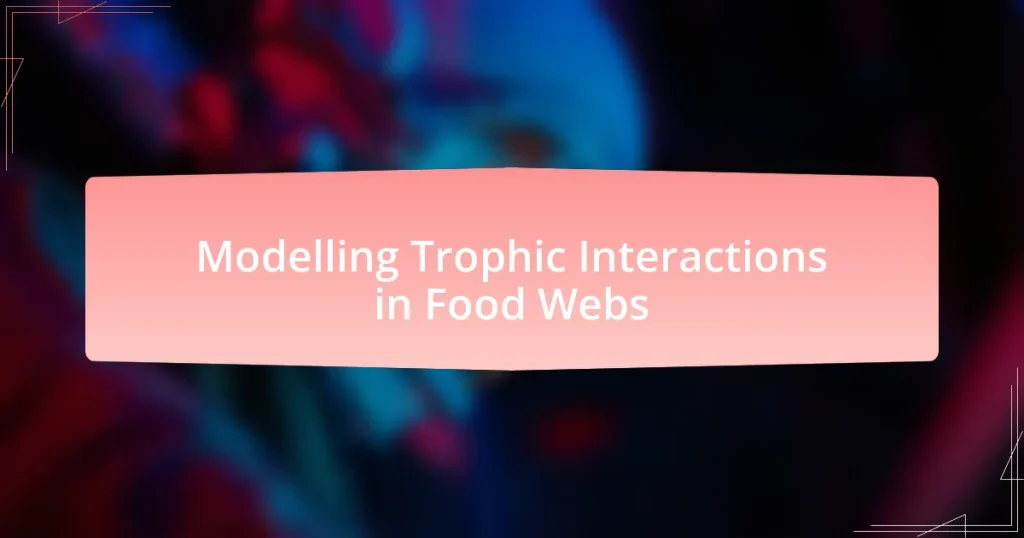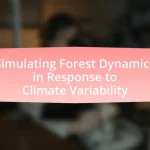Modelling trophic interactions in food webs is a critical aspect of understanding ecosystem dynamics, focusing on the relationships between producers, consumers, and decomposers. This article explores the structure and function of trophic levels, detailing how energy and nutrients flow through these levels and the importance of these interactions for ecosystem health and biodiversity. It also examines various methods for modelling trophic interactions, including mathematical and simulation models, and discusses the applications of these models in ecosystem management and conservation efforts. Additionally, the article addresses the limitations and uncertainties in current models and outlines best practices for improving accuracy in trophic interaction modelling.

What are Trophic Interactions in Food Webs?
Trophic interactions in food webs refer to the relationships between organisms based on their feeding habits, specifically how energy and nutrients flow through different levels of the ecosystem. These interactions are categorized into various trophic levels, including producers, consumers, and decomposers, which collectively illustrate the complex interdependencies among species. For instance, primary producers like plants convert sunlight into energy, which is then consumed by primary consumers such as herbivores, followed by secondary consumers like carnivores. This hierarchical structure is essential for understanding ecosystem dynamics, as it highlights the roles of different species in energy transfer and nutrient cycling.
How do Trophic Levels function within Food Webs?
Trophic levels function within food webs by categorizing organisms based on their position in the energy flow and nutrient cycling. In a food web, producers occupy the first trophic level, converting solar energy into biomass through photosynthesis. Primary consumers, or herbivores, form the second trophic level by feeding on producers. Secondary consumers, which are carnivores that eat herbivores, represent the third trophic level, while tertiary consumers, or top predators, occupy the fourth level. Each level is interconnected, illustrating the transfer of energy and nutrients, with energy decreasing as it moves up the levels due to the inefficiency of energy transfer, typically around 10% per trophic level. This structure is essential for understanding ecosystem dynamics and species interactions.
What defines each Trophic Level in a Food Web?
Each trophic level in a food web is defined by its position in the energy flow and its role in the ecosystem. The first trophic level consists of primary producers, such as plants and phytoplankton, which convert solar energy into biomass through photosynthesis. The second trophic level includes primary consumers, or herbivores, that feed on primary producers. The third trophic level comprises secondary consumers, typically carnivores that eat primary consumers. The fourth trophic level consists of tertiary consumers, which are apex predators that feed on secondary consumers. Finally, decomposers, such as fungi and bacteria, break down dead organic matter, recycling nutrients back into the ecosystem. This hierarchical structure illustrates the flow of energy and nutrients, with each level relying on the one below it for sustenance.
How do energy and nutrients flow through Trophic Levels?
Energy and nutrients flow through trophic levels in a food web by transferring from producers to consumers and decomposers. Producers, such as plants, convert solar energy into chemical energy through photosynthesis, forming the base of the trophic structure. Primary consumers, or herbivores, consume these producers, obtaining energy and nutrients. Secondary consumers, or carnivores, then feed on primary consumers, continuing the energy transfer. Decomposers break down dead organic matter, recycling nutrients back into the ecosystem, which supports producers. This flow is governed by the 10% rule, where only about 10% of energy is transferred to the next trophic level, illustrating energy loss at each stage.
Why are Trophic Interactions important for Ecosystem Health?
Trophic interactions are crucial for ecosystem health because they regulate population dynamics and energy flow within food webs. These interactions, which include predator-prey relationships and competition among species, maintain biodiversity and ecosystem stability. For instance, the presence of apex predators can control herbivore populations, preventing overgrazing and promoting plant diversity, which in turn supports various other species. Research has shown that ecosystems with intact trophic interactions are more resilient to environmental changes, as evidenced by studies indicating that areas with diverse trophic levels recover more quickly from disturbances compared to those with simplified food webs.
What roles do producers, consumers, and decomposers play?
Producers, consumers, and decomposers play essential roles in ecosystems by forming a food web that sustains life. Producers, such as plants and algae, convert sunlight into energy through photosynthesis, forming the base of the food web. Consumers, including herbivores and carnivores, obtain energy by eating producers or other consumers, thus transferring energy through the trophic levels. Decomposers, like fungi and bacteria, break down dead organic matter, recycling nutrients back into the soil, which supports producers. This cyclical process is vital for ecosystem health, as it maintains the flow of energy and the recycling of nutrients, ensuring sustainability.
How do Trophic Interactions influence biodiversity?
Trophic interactions significantly influence biodiversity by determining the structure and dynamics of ecosystems. These interactions, which include predator-prey relationships and competition among species, shape community composition and species richness. For instance, the presence of top predators can regulate the populations of herbivores, preventing overgrazing and allowing a diverse array of plant species to thrive, which in turn supports various other organisms. Research has shown that ecosystems with complex trophic interactions tend to have higher biodiversity, as evidenced by studies indicating that diverse food webs enhance ecosystem stability and resilience (e.g., the work of Paine in 1966 on keystone species). Thus, trophic interactions are crucial for maintaining ecological balance and promoting a rich variety of life forms.

What methods are used for Modelling Trophic Interactions?
Various methods are used for modeling trophic interactions, including mathematical modeling, simulation models, and network analysis. Mathematical modeling often employs differential equations to describe population dynamics and interactions among species, while simulation models, such as agent-based models, allow for the exploration of complex behaviors and interactions in ecosystems. Network analysis focuses on the structure and dynamics of food webs, utilizing tools like graph theory to understand the relationships between species. These methods are validated through empirical data and case studies, demonstrating their effectiveness in capturing the complexities of trophic interactions in ecological systems.
How do Ecological Models represent Food Webs?
Ecological models represent food webs by illustrating the complex interactions between various species within an ecosystem, highlighting the flow of energy and nutrients. These models utilize graphical representations, such as diagrams or matrices, to depict trophic levels and the relationships between producers, consumers, and decomposers. For instance, a common approach is the use of network models, which quantify the connections and interactions among species, allowing researchers to analyze stability, resilience, and the impact of species loss. Studies have shown that these models can predict ecosystem responses to changes, such as species extinction or environmental shifts, thereby providing valuable insights into ecological dynamics.
What are the different types of Ecological Models used?
The different types of ecological models used include empirical models, theoretical models, and simulation models. Empirical models are based on observed data and relationships within ecosystems, allowing for predictions based on historical data. Theoretical models, on the other hand, are grounded in ecological theory and often use mathematical equations to represent interactions and processes. Simulation models, such as agent-based models and system dynamics models, simulate the behavior of individual components within an ecosystem to understand complex interactions and dynamics. These models are essential for studying trophic interactions in food webs, as they provide insights into species interactions, population dynamics, and ecosystem responses to changes.
How do these models simulate Trophic Interactions?
Models simulate trophic interactions by representing the feeding relationships and energy flow between different species within an ecosystem. These models often utilize mathematical equations to depict how changes in one population affect others, incorporating factors such as predation rates, resource availability, and species interactions. For instance, the Lotka-Volterra equations are commonly used to model predator-prey dynamics, illustrating how the population sizes of predators and prey influence each other over time. Additionally, simulation software like Ecopath with Ecosim allows researchers to create detailed food web models that account for multiple species and their interactions, providing insights into ecosystem stability and resilience.
What data is essential for accurate Trophic Interaction Modelling?
Accurate Trophic Interaction Modelling requires data on species abundance, feeding relationships, and energy flow within ecosystems. Species abundance data provides insights into population sizes and distributions, which are crucial for understanding interactions. Feeding relationships detail which species consume others, forming the basis of the food web structure. Energy flow data quantifies the transfer of energy between trophic levels, essential for assessing ecosystem dynamics. Collectively, these data types enable the construction of reliable models that reflect real-world ecological interactions.
How is empirical data collected for Food Web studies?
Empirical data for Food Web studies is collected through various methods including field sampling, laboratory experiments, and remote sensing. Field sampling involves collecting organisms and environmental data from specific habitats to analyze species interactions and abundance. Laboratory experiments allow researchers to manipulate variables and observe interactions in controlled settings, providing insights into trophic dynamics. Remote sensing techniques, such as satellite imagery, help in assessing habitat changes and species distributions over larger areas. These methods collectively enable researchers to gather quantitative and qualitative data essential for modeling trophic interactions in food webs.
What challenges exist in data collection and analysis?
Challenges in data collection and analysis for modeling trophic interactions in food webs include data availability, data quality, and methodological limitations. Data availability is often restricted due to the difficulty in accessing comprehensive datasets that cover diverse species and their interactions. For instance, many ecosystems lack extensive longitudinal studies, leading to gaps in understanding species dynamics. Data quality issues arise from inconsistencies in measurement techniques and reporting standards, which can skew results and hinder accurate modeling. Methodological limitations, such as the complexity of interactions and the need for advanced statistical techniques, further complicate the analysis. These challenges are documented in studies like “Challenges in Ecological Modeling” by McGill et al., which highlights the importance of robust data for effective ecological modeling.

What are the applications of Modelling Trophic Interactions?
Modelling trophic interactions has several applications, including ecosystem management, biodiversity conservation, and predicting the impacts of environmental changes. These models help in understanding the complex relationships between species, allowing for informed decision-making in conservation efforts. For instance, studies have shown that trophic models can predict the effects of species loss on ecosystem stability, which is crucial for maintaining biodiversity. Additionally, they are used in fisheries management to assess fish populations and their interactions with other species, ensuring sustainable practices.
How can Modelling inform Conservation Efforts?
Modelling can inform conservation efforts by simulating trophic interactions within ecosystems, allowing researchers to predict the impacts of environmental changes on species populations. For instance, models can illustrate how the removal of a keystone species affects the entire food web, highlighting potential declines in biodiversity. Studies, such as those by McCann et al. (1998) in “Complexity in Food Webs,” demonstrate that understanding these interactions through modelling can guide effective management strategies, ensuring the preservation of critical habitats and species.
What insights can models provide for habitat restoration?
Models can provide critical insights for habitat restoration by simulating ecological interactions and predicting outcomes of various restoration strategies. These models help identify key species and their roles within food webs, allowing for targeted interventions that enhance biodiversity and ecosystem resilience. For instance, research has shown that models can predict how the reintroduction of a keystone species can lead to significant improvements in habitat structure and function, as evidenced by studies on sea otters in kelp forest ecosystems. By analyzing trophic interactions, models can also reveal potential unintended consequences of restoration efforts, ensuring that strategies are both effective and sustainable.
How do models help in managing fisheries and wildlife?
Models assist in managing fisheries and wildlife by simulating ecological interactions and predicting population dynamics. These models enable resource managers to assess the impacts of fishing practices, habitat changes, and climate variations on species populations. For instance, the use of ecosystem models, such as the Ecopath with Ecosim framework, allows for the evaluation of trophic interactions and the sustainability of fish stocks, providing data-driven insights that inform management decisions. Studies have shown that incorporating model predictions can lead to more effective conservation strategies, as evidenced by the successful recovery of overfished species in various regions when management practices are guided by model outputs.
What are the limitations of current Trophic Interaction Models?
Current Trophic Interaction Models face several limitations, including oversimplification of complex ecosystems, reliance on static parameters, and inadequate representation of species interactions. These models often assume linear relationships and do not account for non-linear dynamics, which can lead to inaccurate predictions of ecosystem responses. Additionally, many models fail to incorporate temporal variability and spatial heterogeneity, limiting their applicability to real-world scenarios. Research indicates that these limitations can result in significant discrepancies between model predictions and observed ecological outcomes, undermining their utility in effective ecosystem management and conservation efforts.
What uncertainties exist in predicting ecological outcomes?
Uncertainties in predicting ecological outcomes primarily stem from the complexity of trophic interactions within food webs. These interactions involve numerous species, each with varying behaviors, life cycles, and responses to environmental changes, making it difficult to model accurately. For instance, the non-linear relationships between predator and prey populations can lead to unpredictable dynamics, as evidenced by studies showing that small changes in one species can disproportionately affect others in the web. Additionally, external factors such as climate change, habitat destruction, and pollution introduce further unpredictability, as these stressors can alter species interactions and ecosystem functions in unforeseen ways. The inherent variability in ecological systems, combined with limitations in data and modeling techniques, contributes to the uncertainties in ecological predictions.
How can models be improved for better accuracy?
Models can be improved for better accuracy by incorporating more comprehensive data on species interactions and environmental variables. Enhanced accuracy can be achieved through the integration of high-resolution ecological data, which allows for a more nuanced understanding of trophic interactions. For instance, studies have shown that models utilizing detailed species-specific parameters and real-time environmental data can significantly reduce prediction errors in food web dynamics. Research published in “Ecological Modelling” by Dunne et al. (2013) demonstrates that models incorporating multi-trophic levels and complex interaction networks yield more reliable outcomes, thereby validating the importance of data richness in model accuracy.
What best practices should be followed in Trophic Interaction Modelling?
Best practices in Trophic Interaction Modelling include using accurate species interaction data, employing appropriate mathematical frameworks, and validating models with empirical data. Accurate species interaction data ensures that the relationships between different organisms are correctly represented, which is crucial for reliable predictions. Employing appropriate mathematical frameworks, such as Lotka-Volterra equations or matrix models, allows for the effective representation of complex interactions within food webs. Validating models with empirical data, such as field observations or experimental results, confirms the model’s accuracy and enhances its predictive power. These practices are essential for developing robust trophic interaction models that can inform ecological research and management.


